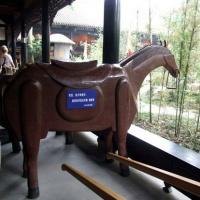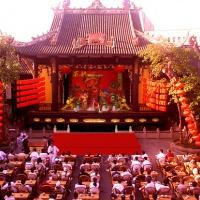Wuhou Temple was built in memory of Zhuge Liang, the Prime Minister of the Shu during the period of Three Kingdoms. To Chinese people, Zhuge Liang was the personification of noble character and intelligence. Memorial temples erected in many places after his death in China.
The temple, located in the south suburb of Chengdu city, covers 37,000 square meters (398,277 square feet). The establishing date the temple is is unknown and it is said to be built after ChaoLie Temple in commemoration of Liu Bei (the emperor of Shu). These two temples were merged in early Ming Dynaty. The current temple was rebuilt in 1672.



Surrounded by old cypresses and classical red walls, the temple evokes nostalgia and displays the suppleness of the Chinese garden. The main body of the temple is divided into five sections, the Gate, the second Gate, the Hall of Liu Bei, the corridor, and the Hall of Zhuge Liang, all of which run south to north. Inside, clay sculptures of Shu Emperor and ministers stand together, making them a special feature. 
There are a lot of historical relics such as horizontal cribbed boards, couplets, inscribed tablets, penmanship, furnaces, Chinese tripods, etc. The most valuable cultural relic within the temple is the Triple-Success Stele, as huge as 367-centimeter (144-inch) high and 95-centimeter (37-inch) wide and set up in 809.
The inscripts of stele is an article, written by Pei Du, a famous minister of the Tang Dynasty who served four emperors in succession, with the calligraphy of Liu Gongquan, one of the most brilliant calligraphers in Chinese history, which states the loyal morality and millitary tactic achievements of Zhuge Liang.
A visit to the temple illuminates his status among the Chinese people.
